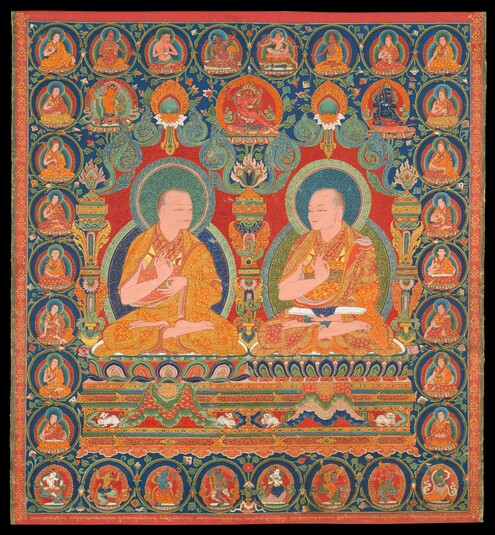
Item: Teacher (Lama) - Lhachog Sengge
| Origin Location | Tibet |
|---|---|
| Date Range | 1500 - 1599 |
| Lineages | Sakya, Ngor (Sakya) and Buddhist |
| Material | Ground Mineral Pigment on Cotton |
| Collection | Private |
Lhachog Sengge (1468-1535) and Konchog Lhundrub 1497-1557), the 9th and 10th Abbots of Ngor Monastery, Tsang Province, Tibet, accompanied by the Shri Virupa lineage of Rakta Yamari. There are two other known works that are from this same mid 16th century painting atelier. One of the works resides in a private collection and the other resides in a Ngor Monastery in Ladakh, India.

At the top center of the composition the lineage of Rakta Yamari alternates to the right and left sides before descending down the two vertical registers at the left and right sides. Directly above and between the two central figures is a small figure of Rakta Yamari, red in colour, with one face and two hands, embracing the consort Vajra Vetali. To the viewer's left side is Orange Manjushri, peaceful in appearance, holding an upraised sword and a book. On the viewer's right side is Heruka Vajrabhairava, wrathful, dark blue, having a buffalo face, two hands holding a curved knife and a skullcup. There are eight offering goddesses in the lower register each in a different colour and standing in a dancing posture.
Translation of the inscription along the bottom of the composition:
"To the teachers and host of deities,
Gladdening with supreme devotion,
Possessing the treasure of Tantra and instructions;
Homage to the Lion's Roar.
As the lord master of the nature of the Three Jewels,
Rich with the treasure of discipline, hearing, thinking and meditating,
Skillfully spreading spontaneous activity in all directions:
I pray to the intelligent spiritual friend.
To the principal teacher and lineage I pray - bless the knowledge holder Sanggye Sengge."
The first verse is dedicated to Lhachog Sengge and the second verse to Konchog Lhundrub. The final line is most probably intended for the 11th abbot of Ngor, Sanggye Sengge (1504-1569).
Jeff Watt 3-2015
Teacher: Ngorchen Konchog Lhundrub
Teacher: Lhachog Sengge
Collection: Bonhams, Painting (March, 2015; New York)
Subject: Margapala Lineage Masterworks
Subject: Teachers (Art Topics & Medium)


